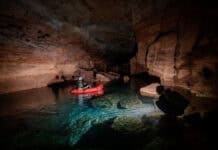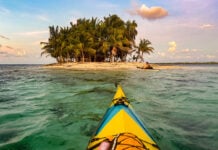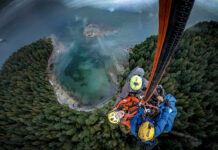In May 2020, Steve Markle, vice president of sales and marketing for American rafting and sea kayaking outfitter OARS, was faced with the task of processing thousands of trip cancellations.
“It was a very challenging time. We didn’t know what the future looked like,” he recalls. A year later, OARS is on the verge of an unprecedented season. For the first time in nearly two decades, it’s nearly sold-out of its multiday trips in the western United States.
“The enthusiasm for booking guided outdoor activities is off the charts,” says Markle. “People realize a guided paddling trip might be one of the best possible options for vacationing during a pandemic.”
During the pandemic, the interest in paddlesports grew exponentially. By June 2020, dollar sales of canoes, kayaks and paddleboards in the United States had increased by 56 percent compared to June 2019, reaching $172 million in sales, according to market research group NDP. Money people would normally earmark for a holiday was being invested into getting on the water. Now, with vaccines rolling out, this interest is translating to holidays.
Based on an analysis of Google searches before and during the pandemic, the World Travel & Tourism Council predicts adventure travel will be the first sector to make a full recovery. And according to a 2020 study conducted by the Adventure Travel Trade Association (ATTA), adventure travel is likely to recover three to four years earlier than mass travel.
It could be the allure of fresh air, the introduction of more flexible cancellation policies, or the fact adventure travelers are generally less risk-averse. However, even as multiday water trips are experiencing a surge in popularity, they’re not the same carefree days in the wilderness they once were.

The most obvious change is to health and safety procedures. Although being well-versed in risk management has always been part of the job description for outfitters, it’s now at the forefront, with group sizes reduced and mask-wearing enforced. For its part, OARS created a comprehensive 32-page COVID-19 health and safety document, which Markle describes as “modest.”
Improved health and safety procedures are the most superficial changes. The true effects of the pandemic are likely going to be felt for years to come. Jobs in tourism—which just over a year ago was perceived as a secure and growing industry, contributing $2.9 trillion to the global economy—is now a precarious career choice. Even with outfitters experiencing a high volume of bookings for 2021, an outbreak or lockdown could mean a massive loss of income for kayaking guides, who are often employed seasonally and paid per trip.
While government wage subsidy programs have helped outfitters like British Columbia’s Spirit of the West Adventures keep staff on payroll, co-owner Rick Snowdon believes the skills gap will be felt in a few years.
“It’s not something that’s affected us yet, but it’s going to become apparent when guided trips pick back up,” he says. “We’re going to be scrambling to find qualified guides. There’ll be a training gap due to the pandemic forcing people into other professions.”
Along with the challenges have come opportunities. In the last year, the social justice movement has given rise to groups like the Black Travel Alliance, holding outfitters accountable for improving diversity outdoors through their marketing and hiring practices. There’s also increased focus on environmental sustainability, with the climate crisis remaining at the forefront of travelers’ minds. While many outfitters are banking on open air as the top-selling feature, Adventure Travel Trade Association CEO Shannon Stowell believes the sector’s rapid recovery is because of something else.
“Adventure travel is passion driven,” he says. “Kayakers, birders and cyclists are people who partly define who they are by those activities. It gives me a lot of hope for the strength of recovery.”
This article was first published in Paddling Magazine Issue 64. Subscribe to Paddling Magazine’s print and digital editions here, or download the Paddling Magazine app and browse the digital archives here.
Pre-pandemic, the Trump administration was the topic that could quickly cause a fracture in cohesive group dynamics on trip; COVID-19 could be the new polarizing topic. | Photo: Brendan Kowtecky









